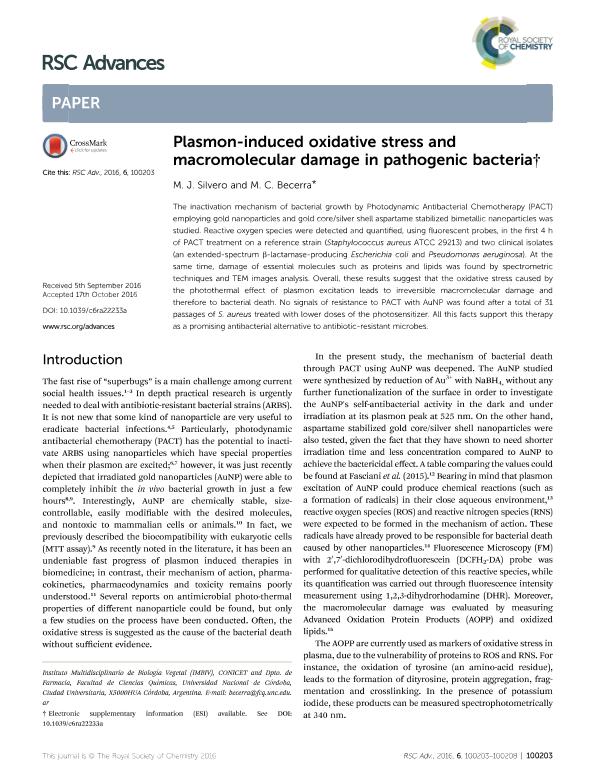Artículo
Plasmon-induced oxidative stress and macromolecular damage in pathogenic bacteria
Fecha de publicación:
10/2016
Editorial:
Royal Society of Chemistry
Revista:
RSC Advances
ISSN:
2046-2069
Idioma:
Inglés
Tipo de recurso:
Artículo publicado
Resumen
The inactivation mechanism of bacterial growth by Photodynamic Antibacterial Chemotherapy (PACT) employing gold nanoparticles and gold core/silver shell aspartame stabilized bimetallic nanoparticles was studied. Reactive Oxygen Species were detected and quantified, using fluorescent probes, in the first 4 h of PACT treatment on a reference strain (Staphylococcus aureus ATCC 29213) and two clinical isolates (an extended-spectrum β-lactamase-producing Escherichia coli and Pseudomonas aeruginosa). At the same time, damage of essential molecules such as proteins and lipids was found by spectrometric techniques and TEM images analysis. Overall, these results suggest that the oxidative stress caused by the photothermal effect of plasmon excitation leads to irreversible macromolecular damage and therefore to bacterial death. No signals of resistance to PACT with AuNP was found after a total of 31 passages of S. aureus treated with lower doses of the photosensitizer. All this facts support this therapy as a promising antibacterial alternative to antibiotic-resistant microbes.
Palabras clave:
Plasmon
,
Antibacterial
,
Oxidative-Stress
,
Nanoparticle
Archivos asociados
Licencia
Identificadores
Colecciones
Articulos(IMBIV)
Articulos de INST.MULTIDISCIPL.DE BIOLOGIA VEGETAL (P)
Articulos de INST.MULTIDISCIPL.DE BIOLOGIA VEGETAL (P)
Citación
Silvero, María Jazmín; Becerra, María Cecilia; Plasmon-induced oxidative stress and macromolecular damage in pathogenic bacteria; Royal Society of Chemistry; RSC Advances; 102; 6; 10-2016; 100203-100208
Compartir
Altmétricas




